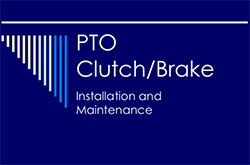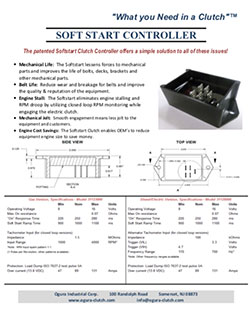PTO Clutch Installation
PTO Clutch Installation
Installation of a Bearing Mounted PTO Clutch/Brake
A bearing mounted clutch/brake refers to a unit that has the bearing mounted in the field/rotor assembly.
Step 1
Slide the clutch onto the shaft, (for a two-piece clutch, slide both pieces on one at a time) making sure that the key is in the proper location. Do not force the clutch onto the shaft because if the key is off slightly, damage could occur to the key or to the bore of the clutch. The clutch should be slid onto the shaft until the bearing inner race on the clutch contacts a step, washer or other drive pulley. In all cases, the mounting surfaces of these components need to be parallel to each other within .003". If these surfaces are not parallel, the clutch could become cocked on the shaft. (This would show up as a wobbling pulley.) The contact of these components, to the bearing inner race, can extend beyond the inner race because the seal is recessed. (If you are using a washer, make sure it is not cupped otherwise this cupping could dig into the bearing seal.) Make sure to check the chamfer on the ground drive pulley, washer or clutch so they do not interfere with the radius on the step in the engine crankshaft. On some of our clutches, the bearing is kept on the inner sleeve via a snap ring, (pulley side). With this design, the rotor would then contact the appropriate step in the shaft.
Step 2
A center bolt and washer (customer supplied) is then placed into the end of the tapped shaft and then tightened down. The washer should be .250" in thickness.
Bolt tightening torque will vary depending upon the bolt used in the application. This can be anywhere from 20 \uffff 50 ft. lbs. of tightening torque depending upon the bolt. If vibration is heavy an adhesive may be required to prevent the bolt from coming loose. The washer should contact the inner race of the bearing. It can extend beyond the inner race as long as it does not contact the outer race.
Step 3
If the torque restraining piece has not been installed, please do so at this time. Whichever method you choose to restrict rotation of the backing plate, please make sure that there is 1/16" of both axial and radial movement allowed in the backing plate of the clutch/brake. Without this movement, the backing plate can cock the field bearing which would cause a premature field bearing failure. Whether you choose to use the slot that is already manufactured in the clutch or other method, please make sure that your hardware can hold the braking torque of the brake, which can be anywhere from 2.2 to 20 pounds depending upon clutch size.
Step 4
This step is for two piece designs only. Place the springs on to the studs. The brake shroud is then placed on the studs and the nuts are loosely tightened on the studs.
Installation of a Flange Mounted PTO Clutch/Brake
Flange mounted clutches do not have a field bearing and therefore the field has to mount directly on the face of the engine. Please make sure that the engine bearing bore and bolt hole locations are compatible with our clutch field. In these types of applications, an inboard ground drive pulley cannot be used. In general, field mounted clutches are not as flexible as bearing mounted clutches and with the cost of installation time, they are not as widely used.
The assembly consists of four separate items. They are the:
field Provides magnetic flux for engagement
Rotor Connected to the engine shaft and is the input to the clutch
Armature/pulley Is the output of the clutch
Brake shroud assembly Assists in slowing the mower blades to a stop
Step 1
Mount the field on the engine. Pilots on the back of the field line up and locate on the bearing bore on the engine block. Once this pilot is slid into the bearing bore, the four bolts to hold the field onto the engine face should be installed and tightened. (Torque to be determined by bolt used and engine thread size.)
Step 2
Place the key (customer supplied) into the shaft keyway. Slide the rotor onto the shaft. The rotor should be slid back all the way until it contacts the step on the engine shaft. If no contact is made or the rotor can slide all the way until it contacts the field, there is a problem in using this clutch. You need to adjust installation at this point by putting some type of spacer between the engine shaft step and the clutch rotor. Please refer to individual clutch drawing for this dimension.
Step 3
Slide the pulley/armature onto the shaft. This should fit flush against the rotor face. Depending upon clutch style, there may or may not be a keyway underneath this area. (If there is no keyway underneath this area, make sure your key does not extend into this piece.)
Step 4
The center bolt and washer is then installed to keep the entire assembly together. The center bolt should be tightened down to the bolt manufacturer recommendations. Usually 20-50 lb. ft. of torque is required. Please make sure that the washer contacts the inner race of the bearing. The washer can extend beyond the inner race as long as it does not contact the outer race because the seal is recessed. Please make sure the washer is not cupped in the direction of the seal or the seal will be damaged.
Step 5
The springs and the brake shroud are then placed on the units and the gap adjustment nuts are loosely tightened down.
Air Gap Adjustment
If you have a bearing mounted one-piece design your clutch should automatically be adjusted at the factory and no adjustment is required. This section is for your reference only. Please proceed to the burnishing section. If you have a two piece design or a flange mount design, please adjust using the following procedure:
Step 1
Mount all components to the clutch according to our installation procedure. Please make sure that the brake plate and coil springs are in the proper position. Start to tighten down the gap adjustment nuts. The same number of turns should be applied to each nut successively so the adjustment is as even as possible.
Step 2
There are three inspection slots on the brake cover. With a feeler gauge of between .013-.015 for clutches used on 25 horsepower and under, and .015-.022 for clutches used on 25-31 horsepower, tighten each nut down until slight contact is felt on the feeler gauge. Once all three are finished, go back and check the air gap (occasionally some minor adjustment will be required).
Step 3
Once the air gap is within the specified range, engage the clutch at full coil voltage and rotate it. If there is no contact on the brake shroud, the clutch is okay; however, if there is any contact with the brake shroud, the gap adjustment nuts should be backed off slightly to eliminate the contact.
Burnishing
Burnishing is the cycling of the clutch to allow a wearing in of the engagement surface area which increases the torque transmitted. The reason for burnishing a clutch is to increase the initial starting torque. If the starting torque required from the clutch is less than half of what the torque rating is, no burnishing is required. If there is a potential for high torque to be initially required from the clutch, burnishing should be done.
To burnish a clutch, reduce the engine speed to about half. A typical burnishing time will take anywhere from 5 to 30 cycles depending upon inertia. The burnishing frequency should be done at 2 to 6 cycles per minute. Frequency of cycles and amount of cycles required will depend upon inertia. Typically the larger the inertia, the fewer cycles per minute allowed, and the fewer overall cycles required. (For a specific recommendation for your application, please contact us.)

